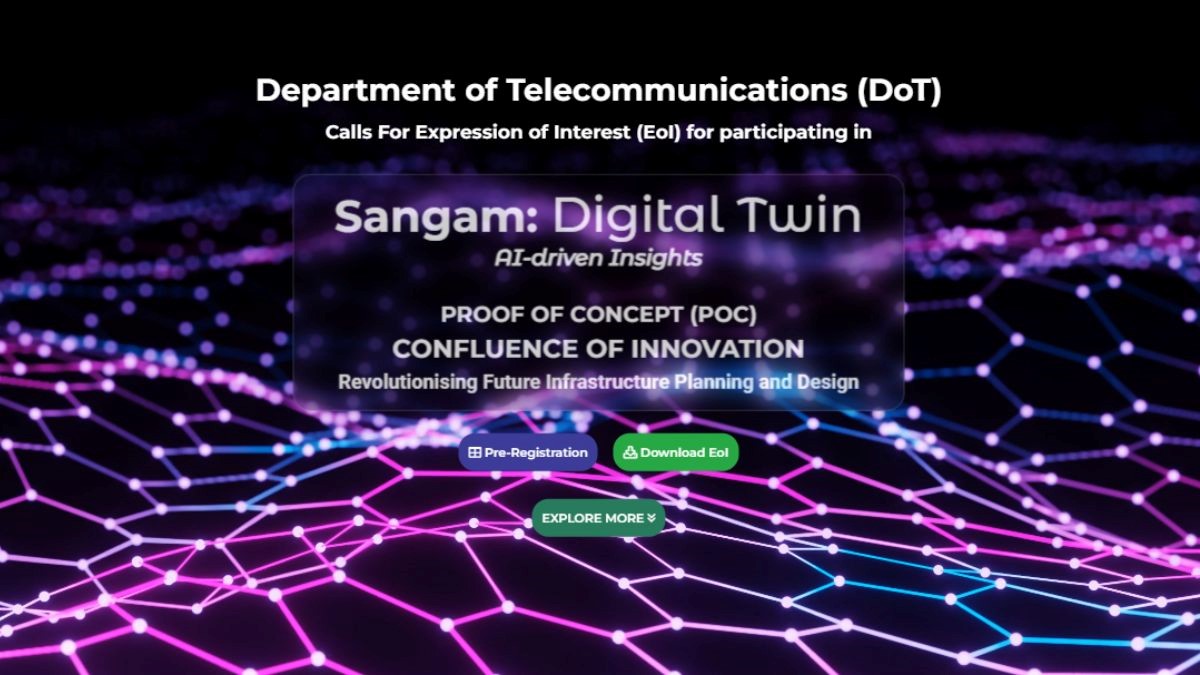Description

Disclaimer: Copyright infringement not intended.
Context
- The Department of Telecommunications (DoT) has introduced the 'Sangam: Digital Twin' initiative, a pioneering venture aimed at harnessing the power of Digital Twin technology for transformative infrastructure planning and design.
- The initiative invites Expressions of Interest (EoI) from a diverse range of stakeholders, including industry leaders, startups, MSMEs, academia, and innovators.
Details
Purpose and Scope
- The 'Sangam: Digital Twin' initiative seeks to leverage Digital Twin technology to create virtual replicas of physical assets, enabling real-time monitoring, simulation, and analysis.
- It comprises two stages: an Exploratory phase for creative exploration and horizon clarity, followed by a practical demonstration stage focusing on specific use cases to generate future blueprints for scalability and replication.
Technological Integration
- The initiative integrates cutting-edge technologies such as 5G, IoT, AI, AR/VR, AI-native 6G, and next-gen computational technologies.
- By combining these technologies with the collective intelligence of various stakeholders, 'Sangam' aims to break silos and foster collaboration for infrastructure innovation.
Objectives
- Demonstrate practical implementation of innovative infrastructure planning solutions.
- Develop a model framework for facilitating faster and more effective collaboration.
- Provide a future blueprint for scaling and replicating successful strategies in future infrastructure projects.
Platform Features
- The Sangam website (https://sangam.sancharsaathi.gov.in) serves as a central hub for information and pre-registration.
- Participants can access a blog to connect, share insights, and engage in discussions.

Introduction to Digital Twin Technology
- These virtual models are highly detailed and dynamic, mirroring the behavior and performance of their real-world counterparts in real-time.
- By integrating data from various sources and leveraging advanced analytics, Digital Twins enable organizations to gain deeper insights, optimize operations, and facilitate innovation across industries.
Key Components of Digital Twin Technology:
- Physical Asset: The physical asset, which could range from industrial machinery and infrastructure to entire cities or ecosystems, serves as the basis for creating the Digital Twin.
- Virtual Model: The virtual model is a digital representation of the physical asset, built using advanced modeling and simulation techniques. It incorporates geometric, behavioral, and contextual data to accurately reflect the asset's characteristics and behavior.
- Sensors and IoT Devices: Sensors and Internet of Things (IoT) devices deployed on the physical asset collect real-time data on parameters such as temperature, pressure, vibration, and more. This data is then used to update the virtual model and provide insights into the asset's performance.
- Data Analytics and Machine Learning: Advanced data analytics techniques, including machine learning algorithms, are employed to analyze the vast amounts of data collected from the physical asset and derive actionable insights. These insights help optimize performance, predict maintenance needs, and drive decision-making.
- Connectivity and Integration: Digital Twins rely on seamless connectivity and integration with various data sources, including IoT devices, enterprise systems, and external data sources. This ensures that the virtual model remains up-to-date and accurate, reflecting real-world changes in real-time.
Applications of Digital Twin Technology:
- Manufacturing and Industry 4.0: In manufacturing, Digital Twins are used to simulate production processes, optimize equipment performance, and predict maintenance needs. They enable predictive maintenance, reduce downtime, and improve overall efficiency.
- Smart Cities and Infrastructure: Digital Twins are employed in urban planning and infrastructure management to model and simulate entire cities or specific infrastructure components. They help city planners optimize traffic flow, manage energy consumption, and enhance public safety.
- Healthcare: In healthcare, Digital Twins are utilized to create personalized models of patients for diagnosis, treatment planning, and medical research. They enable precision medicine, improve patient outcomes, and drive innovation in healthcare delivery.
- Aerospace and Defense: Digital Twins play a crucial role in aerospace and defense applications, where they are used to simulate aircraft performance, optimize maintenance schedules, and enhance mission planning. They enable proactive maintenance, reduce costs, and enhance operational readiness.
- Energy and Utilities: In the energy and utilities sector, Digital Twins are employed to monitor and optimize energy generation, distribution, and consumption. They enable predictive maintenance of critical infrastructure, improve grid resilience, and support the transition to renewable energy sources.
Challenges and Considerations:
- Data Privacy and Security: With the proliferation of data collection and sharing, ensuring the privacy and security of sensitive information associated with Digital Twins is paramount.
- Interoperability and Standards: Establishing interoperability standards for Digital Twins and ensuring compatibility with existing systems and data sources remains a challenge.
- Scalability and Complexity: As Digital Twins become more sophisticated and encompass larger and more complex systems, scalability and managing complexity become significant concerns.
- Ethical and Regulatory Considerations: Addressing ethical concerns related to the use of Digital Twins, such as accountability, transparency, and fairness, is essential to fostering trust and acceptance.

Conclusion
The 'Sangam: Digital Twin' initiative represents a collaborative leap towards reshaping infrastructure planning and design in India. By fostering cross-sectoral collaboration and leveraging advanced technologies, Sangam aims to drive impactful changes in infrastructure development, paving the way for a smarter and more sustainable future.
|
PRACTICE QUESTION
Q. Digital Twin technology represents a paradigm shift in how organizations conceptualize, design, and manage physical assets and systems. Critically Analyse. (15 marks)
|










